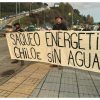Monday, May 6, 2024
News and Views from the Global South
ENVIRONMENT-PERU: Weaker El Niño Still to Affect Andean Glaciers
Abraham Lama
- El Niño is predicted to return during the coming Southern Hemisphere summer, and is already causing some nervousness in Peru, one of the countries most exposed to the effects of this cyclical climatic phenomenon that originates in the Pacific Ocean currents.
The World Meteorological Organisation (WMO) released a forecast this week in Geneva that El Niño will be much less intense than in its last appearance in 1997-1998, but Peruvian experts from various fields are concerned nonetheless.
The phenomenon, which occurs every three to seven years, stems from warm currents in the Pacific Ocean off Australia and Indonesia that shift to the tropical latitudes of the South American coast.
The warm surface temperatures of the ocean alter the climate, triggering severe storms with heavy rainfall in some areas, and causing drought in others.
Pablo Lagos, president of the Geophysics Institute of Peru (IGP), expressed guarded optimism in response to forecasts for “a weak Niño” to occur over the next six to nine months.
“It won’t cause the catastrophic flooding that it did in its more intense cycles, though rainfall will increase, and that could benefit agriculture,” he commented.
For his part, Benjamin Morales, president of the Andean Institute of Glaciology and Geo-Environment, said he is concerned because “the warmer climate would continue to accelerate the process of deglaciation.”
Morales said that this reduction in the ice mass of the upper altitudes of the Andes mountains is a disturbing phenomenon that the international community is studying closely as an indicator also of global warming.
Hydro-meteorologist Aquize Jaén, who works in Puno, a city in the southeastern extreme of Peru, says the temperature in this high plateau region has risen from an average of nine degrees Celsius in the 1960s to 11 degrees today.
“That change has led to a faster evaporation process of Lake Titicaca and more precipitation,” explained Jaén. Lake Titicaca, 3,812 metres above sea level on an Andean plateau, is shared by Peru and Bolivia.
Deglaciation is a threat in the long term for the residents of the Andean and coastal valleys of Peru because smaller glaciers will ultimately mean reduced flows of water in the rivers, which in turn will reduce the country’s hydroelectric production capacity.
Morales pointed out, however, that the immediate impact of El Niño is the acceleration of the glacier melt, which means a greater potential for flooding and mudslides, and the danger of entire villages and farmland being wiped out.
Deglaciation periods in the past have triggered numerous floods in Peruvian valleys, such as the disasters in Huaraz in 1941, Urubamba in 1942, Chavin in 1945 and Ranrahirca in 1962.
The worst catastrophe resulting from this phenomenon occurred in 1970 when an avalanche buried the city of Yungay, in Peru’s northern sierra, killing nearly all of the 20,000 residents.
There are 723 glaciers on Peru’s 18 Andean peaks, concentrating 80 percent of the ice mass found within the tropical latitudes worldwide.
“Those glaciers are the Earth’s most sensitive natural thermometers due to their reaction to the most minor changes in temperature, such that the advance of global warming and the greenhouse effect can be measured with precision in the Peruvian sierra,” Morales said.
Tomás Unger, specialist in development and in technological dissemination, said that “the acceleration of deglaciation in the Andes is one of the indicators of the warming cycle the Earth is now entering, and it is a phenomena that could provoke catastrophic impacts in the short term, such as flooding and drought.”
“Human activity, particularly the growing consumption of fossil fuels, causes greater emissions of carbon dioxide, which is responsible for the phenomenon known as the greenhouse effect and is causing global warming,” stated Unger.
“Climate change is a priority matter for humanity, and the refusal of the United States to ratify the Kyoto Protocol (for curbing carbon emissions) has turned it into a political conflict,” he added.
The Kyoto Protocol to the Framework Convention on Climate Change was signed in 1997 and commits industrialised nations to reduce emissions of greenhouse gases to target rates based on 1990 levels.
But US President George W. Bush refuses to seek Congress’s ratification of the protocol, alleging that it would be too costly for US industry to implement the technical changes necessary to curb emissions to within the limits set by the treaty.
The United States is responsible for 25 percent of the world’s carbon emissions.

 Print
Print



